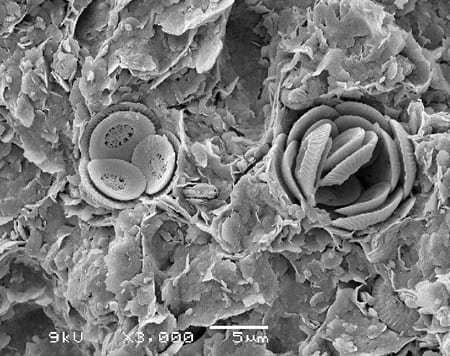Decanted from the speedy flow of information here are a handful of the latest news on Ocean Acidification:
≈≈≈The Third International Symposium on The Ocean in a High-CO2 World took place at the end of last month. You can read the press release at the end of the four-day event HERE, read the reports on how climate change, together with Ocean Acidification is going to challenge global food supplies and what countries will be most affected (The Maldives, Togo, Comoros and Iran top the list) in THIS REUTERS article, see how it might all be written in stone in the series of photographs showing tiny specimens of fossil coccolithophores by Paul Bown, paleaoceanographer at University College London  (please read the NATURE article dedicated to it HERE), or watch a couple of the video recorded talks available on Bambuser
(please read the NATURE article dedicated to it HERE), or watch a couple of the video recorded talks available on Bambuser
Beth Fulton: impacts on Ocean Acidification on food webs and fisheries
Richard Matear: Ocean Acidification and earth system feedbacks
≈≈≈California Report‘s coverage of the Monterey symposium: “Scientists Focus on Ocean Acidification”
≈≈≈We mentioned the Catlin Seaview Survey and their underwater camera work months ago and now it is out for everyone to see and admire through Google Maps.
“Today we’re adding the very first underwater panoramic images to Google Maps, the next step in our quest to provide people with the most comprehensive, accurate and usable map of the world. With these vibrant and stunning photos you don’t have to be a scuba diver—or even know how to swim—to explore and experience six of the ocean’s most incredible living coral reefs. Now, anyone can become the next virtual Jacques Cousteau and dive with sea turtles, fish and manta rays in Australia, the Philippines and Hawaii.”
Go to the GOOGLE MAPS page and watch this introductory video:
≈≈≈Download EPOCA‘s Knowledge Base 2012 (Updating What We Know About Ocean Acidification And Key Global Challenges). Available in English, Spanish, French, Portuguese and German.
≈≈≈The New York Times article “Scientists Adopt Tiny Island as a Warming Bellwether” has received criticism for allegedly depicting a downplayed, relaxed and partial view on the impact of Ocean Acidification. An example of such evaluation written by Susan Webber last Sunday, October 7th.
≈≈≈Sailors for the Sea have put out a list with eight measures any individual sailor can take to fight increasing pollution, acidification and over-fishing. Katie Jewett tells:
1. You can always provision your boat with local produce. Make sure that you are not buying produce that had to be shipped across an ocean to get to you.
2. Divide your rubbish onboard, take it home to be composted or recycled. Use plastic as little as possible and never never let it risk going overboard.
3. Use diesel as little as possible or, if you can, convert to bio fuels.
4. Conserve water with foot-pedal sinks and dish washing.
5. Eliminate use of toxic bottom paints.
6. Prevent any dumping of waste or gray water overboard.
7. Learn more about the problems facing your local area and many bodies of water, by reading about ocean acidification, low oxygen levels, and plastics in the ocean.
8. Find and join a local ocean conservation group and/or Sailors for the Sea to see how you can be part of the solution, not part of the problem.
SOURCE
≈≈≈The US National Science Foundation awarded last month a $ 203,911 grant to the Little Cayman Research Center for building a new coral reef stress wet lab in which to carry out experiments on Ocean Acidification, climate change and fisheries management of grouper and lionfish.
More information HERE
≈≈≈Dr. Bärbel Hönisch, Assistant Professor of Earth and Environmental Science at Columbia University and geochemist at Columbia’s Lamont-Doherty Earth Observatory talks about research on geological records to study Ocean Acidification for NPR’s Academic Minute: AUDIO
≈≈≈Research by NOAA’s William G. Sunda and Wei-jun Cai of the University of Georgia finds that ocean acidification is accelerated in nutrient-rich areas:
“Carbon dioxide released from decaying algal blooms, combined with ongoing increases in atmospheric carbon emissions, leads to increased levels of ocean acidification, and places additional stress on marine resources and the coastal economies that depend on them, according to a new study”
READ MORE HERE
≈≈≈A video from the Washington Post interviewing Kris Holderied, Director of NOAA’s Kasitsna Bay Laboratory about the pH levels on local waters.
≈≈≈Bigelow Laboratory for Ocean Sciences offers a three-year Postdoctoral Research Scientist position in the area of phytoplankton physiology and Ocean Acidification. The application deadline is on October 15th. Information HERE
≈≈≈Life, people, nations and institutions are polyhedral, and with that in mind one can easily understand how the same place best known for its casinos, banks, formula one car races and the highest number of millionaires per capita in the world can also be responsible for launching a new two million dollar Ocean Acidification International Coordination Center that will be based at the International Atomic Energy Agency Environment Laboratories. His Serene Highness Prince Albert II hopes the center will help coordinate international research and link science and policy.
MORE


